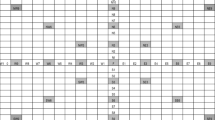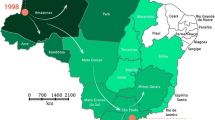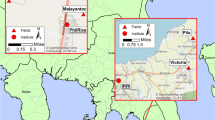Abstract
Ascochyta blight of faba bean, caused by Ascochyta fabae (teleomorph: Didymella fabae) is one of the most destructive diseases of faba bean in Tunisia. Temporal and spatial development of ascochyta blight were studied and characterized during 2010–2011 and 2011–2012 in three faba bean fields located in Oued Mliz, Oued Beja and Mornag, using mathematical and geostatistical analyses. Mass Disease Index (MDI) was assessed every two weeks in each quadrat located around the central source of inoculum. Richards’ function well described disease progress in all sites except for Oued Beja in 2011–2012, the shape parameter m is significantly close to 1 placing the model in its particular form of Gompertz and confirming the polycyclic characteristic of the epidemic. Empirical analysis showed that the effect to locations on epidemic dynamics was explained by highly significant environmental effect (temperature, rain events). These differences in epidemic dynamics were confirmed by the analysis of parameters estimated by the Richards’ model (average relative disease progression rate (rw), proportional average relative disease progression rate (rwp), maximum disease progression rate at inflection point (ri), time at inflection point (ti), MDI at the inflection point (yi)). Analyzing the spatial structure dynamics of the disease using Lloyed Index of Patchiness (LIP) and the mapped disease distribution at different dates showed that LIP was estimated by an exponential functionthat decreased over time in all sites and seasons. LIP dropped below 1 (limit value for aggregated distribution) after 12, 25, 30, 36 and 48 daysat Oued Beja and Oued Mliz during both seasons and during the second season in Mornag. After these periods, the disease distribution is randomly distributed. However, according to the mapping, disease distribution was aggregated in terms of severity even at the end of the epidemics, indicating different temporal dynamics such as changes in distance from the inoculum source.





Similar content being viewed by others
References
Batista L, Velázquez K, Estévez I, Peña I, López D, Reyes ML, Rodríguez D, Laranjeira FF (2008) Spatiotemporal dynamics of Citrus tristeza virus in Cuba. Plant Pathol 57(3):427–437
Bernier CC, Hanounik SB, Hussen MM, Mohamed HA (1984) Field manual of common Faba bean diseases in the Nile Valley. International Center for Agricultural Research in the dry areas, Aleppo, Syria, p 3. Information Bulletin
Bond DA, Pope M (1980) Ascochyta fabae on winter beans (Vicia faba): pathogen spread and variation in host resistance. Plant Pathol 29(2):59–65
Calonnec A, Richard B, Andrivon D, Baranger A, Chauvin J-E et al (2013) PROJET ’ARCHIDEMIO’. Modéliser les interactions entre développement de la plante, architecture du couvert et épidémies de maladies fongiques aériennes, pour une gestion durable des cultures. Innovations Agronomiques, INRA, pp. 201–219. ffhal-01208675f
Camann MA, Culbreath AK, Pickering J, Todd JW, Demski JW (1995). Spatial and temporal patterns of spotted wilt epidemics in peanut. Phytopathology 85:879–885.
Campbell CL, Madden LV (1990) Introduction to plant disease epidemiology. John Wiley & Sons, New York, 532 pp
Carisse O, Tremblay DM, Lefebvre A (2014) Comparison of airborne inoculum progress curves from raspberry, strawberry and grape plantings. Plant Pathol 63(5):983–993
Chelal J, Hau B (2015) Temporal dynamics of powdery mildew (Oidium neolycopersici) and its effects on the host growth dynamics of tomato. J Phytopathol 163:711–722
Correll J, Gordon T, Elliott V (1988) Powdery mildew of tomato: the effect of planting date and triadimefon on disease onset, progress, incidence, and severity. Phytopathology 78(5):512–519
Dale MRT, Dixon P, Fortin M-J, Legendre P, Myers DE, Rosenberg MS (2002) Conceptual and mathematical relationships among methods for spatial analysis. Ecography 25(5):558–577
Das MK, Rajaram S, Mundt CC, Kronstad WE (1992) Inheritance of slow-rusting resistance to leaf rust in wheat. Crop Sci 32(6):1452–1456
Dodd IJ (1971) Some aspects of the biology of AscochytafabaeSpeg (leaf and pot spot of the field bean , Vicia faba L ). PhD thesis. University of Hull, UK 162 pp
Duke NC (1981) Mangrove litter fall data from North-Eastern Australia. AIMS Data Report, CS-81-2, Townsville, Australia, p 200
Ferrandino FJ (2008) Effect of crop growth and canopy filtration on the dynamics of plant disease epidemics spread by aerially dispersed spores. Phytopathology 98(5):492–503
Fininsa C, Yuen J (2002) Temporal progression of bean common bacterial blight (Xanthomonas campestris pv. phaseoli) in sole and intercropping systems. Eur J Plant Pathol 108:485–495
Gaunt R.E., 1983. Shoot diseases caused by fungal pathogens. In:Hebblethwaite PD, ed. the Faba bean (Viciafaba L.). London: Butterworths, 1983, 463–492
Gosme M (2008) Comment analyser la structure spatiale et modéliser le développement spatio-temporel des épiphyties. Phytopathology 30:4–23
Goswami R, Mandal S, Mandal S, Padhy PK, Ray S, Mazumder S (2014) Effect of temperature and arsenic on Aeromonas hydrophila growth, a modelling approach. Biologia 69:825–833
Gottwald TR, Timmer LW, McGuire RG (1989) Analysis of disease progress on citrus canker in nurseries in Argentina. Phytopathology 79:1276–1283
Hau B, Amorim L, Filho AB (1993) Mathematical functions to describe disease progress curves of double sigmoide pattern. Phytopathology 83:928–932
Hewett PD (1966) Ascochyta fabae Speg. On tick bean seed. Plant Pathol 15:161–163
Hughes G, Madden LV (1992a) Aggregation andincidence of disease. Plant Pathol 41:657–660
Hughes G, Madden LV (1992b) Aggregation andincidence of disease: some implications for sampling. Annals Appl Biol 37:25–31
Hunt R (1982) Plant growth curves: the functional approach to plant growth analysis. Edward Arnold, London, 248 pp
Jegger MJ (1983) Analysing epidemics in time and space. Plant Pathol 32:5–11
Jellis GJ, Punithalingam EE (1991) Discovery of Didymellafabae sp. nov., the teleomorph of Ascochytafabae, on faba bean straw. Plant Pathol 40:150–157
Jones DG (1998) The epidemiology of plant diseases. Kluwer Academic Publ, Dordrecht, 444 pp
Kaiser WJ, Wang B-C, Rogers JD (1997) Ascochyta fabae and A. lentis: Host specificity, teleomorphs (didymella), hybrid analysis, and taxonomic status. Plant Dis 81(7):809–816
Kharrat M, Le Guen J, Tivoli B (2006) Genetics of resistance to 3 isolates of Ascochyta fabae on Faba bean (Vicia faba L.) in controlled conditions. Euphytica 151:49–61
Lalancette N, Hickey KD (1986) Disease progression as a function of plant growth. Phytopathology 76:1171–1175
Laloi G, Montarry J, Guibert M, Andrivon D, Michot D, Le May C (2016) Aggressiveness changes in populations of Didymella pinodes over winter and spring pea cropping seasons. Appl Environ Microbiol 82(14):4330–4339
Larkin RP, Gumpertz ML, Ristaino JB (1995) Geostatistical analysis of Phytophthora epidemic development in commercial bell pepper fields. Phytopathology 85:191–203
Li Y, Tebeest DO (2009) Temporal and Spatial Development of Sorghum Anthracnose in Arkansas. Plant Disease 93:287–292
Linders EGA, Van Damme JMM, Zadoks JC (1995) Epidemics of diaporthe-adunca in experimental and in natural- populations of plantago-lanceolata and the effect of partial resistance on disease development. Plant Pathol 45:70–83
Madden LV (1980) Quantification of disease progression. Protection Ecology 2:159–176
Madden LV (1992) Rainfall and dispersal of fungal spores. Advance Plant Pathol 8:39–79
Madden LV (1997) Effects of rainfall on splash dispersal of fungal pathogens. Can J Plant Pathol 19:225–230
Madden LV (2006) Botanical epidemiology: some key advances and its continuing role in disease management. Eur J Plant Pathol 115:3–23
Madden LV, Hughes G (1995) Plant disease incidence: distributions, heterogeneity, and temporal analysis. Annu Rev Phytopathol 33:529–564
Madden LV, Louie R, Knoke JK (1987) Temporal and spatial analysis of maize dwarf mosaic epidemics. Phytopathology 77:148–156
Maurin N, Tivoli B, Onfroy C (1990) Mieux connaître les maladies et leurs agents pathogènes pour mieux les combattre : exemple de l’anthracnose de la féverole. Perspectives Agricoles 146:36–45
McCartney HA, Fitt BDL, West JS (2006) Dispersal of foliar plant pathogens: mechanisms, gradients and spatial patterns. In: Cooke BM, Jones DG, Kaye B (eds) The epidemiology of plant diseases, 2nd edn. Springer, Netherlands, pp 159–192
Meng SX, Huang S (2009) Improved calibration of nonlinear mixed effects models demonstrated on a height growth function. For Sci 55:238–247
Moreira AS, Cônsoli RCM, Barbosa JC, Filho AB, Rezende JAM (2014) Spatiotemporal dynamics of zucchini squash lethal Chlorosis and its relationship with the Frankliniella zucchini population. J Phytopathol 162:481–490
Nelson SC, Campbell CL (1993) Comparative spatial analysis of foliar epidemics on white clover caused by viruses, fungi, and a bacterium. Phytopathology 83:288–301
Nesi CN, Alves G, Ribeiro PJ Jr, May De Moi LL (2014) Heterogeneity of peach rust disease progress within the tree canopy. Eur J Plant Pathol 139:663–677
Nutter FW, Parker SK (1997) Fitting disease progress curves using EPIMODEL. In: Francl LJ, Neher DA (eds) Exercises in plant disease epidemiology. American Phytopathology Society, St. Paul, pp 24–28
Omri Benyoussef N, Le May C, Mlayeh O, Kharrat M (2012) First report of Didymella fabae, teleomorph of Ascochyta fabae on faba bean straw in Tunisia. Phytopathol Mediterr 51(2):369–337
Paulitz CT (1996) Diurnal release of ascospores by Gibberella zeae in inoculated wheat plots. Plant Dis 80:674–678
Pedersen EA, Morrall RAA (1994) Effects of cultivar, leaf wetness duration, temperature, and growth stage on infection and development of Ascochyta blight of lentil. Phytopathology 84:1024–1030
Pedersen EA, Morrall RAA, McCartney HA, Fitt BDL (1994) Dispersal of conidia of Ascochyta fabae f. sp. lentis from infected lentil plant by simulated wind and rain. Plant Pathol 43:50–55
Peever TL, Barve MP, Stone LJ, Kaiser WJ (2007) Evolutionary relationships among Ascochyta species infecting wild and cultivated hosts in the legume tribes Cicereae and Vicieae. Mycologia 99(1):59–77
Perotto MC, Di Rienzo JA, Lanati S, Panonto S, Macchiavelli R, Cafrune EE, Conci VC (2014) Temporal and spatial spread of potyvirus infection and its relationship to aphid populations visiting garlic crops. Australas Plant Pathol 43:623–630
Perry JN (1995) Spatial analysis by distance indices. J Animal Ecol 64:303–314
Pritchard PR, Rowe PS, Rossall S (1989) A comparison of infection of resistant and susceptible lines of field beans (Vicia faba) by Ascochyta fabae. Plant Pathol 38:266–270
Rapilly F (1990) L'épidémiologie en pathologie végétale. Publication de l'Institut National de la Recherche Agronomique, Paris, 317 pp
Rhaiem A, Cherif M, Dyer PS, Peever TL (2007) Distribution of mating types and genetic diversity of ascochyta rabiei populations in Tunisia revealed by mating-type-specific PCR and random amplified polymorphic DNA markers. J Phytopathol 155(10):596–605
Richards FJ (1959) A flexible growth function for empirical Useo title. J Exp Bot 10:290–301
Richard B, Bussière F, Langrume C, Rouault F, Jumel S, Faivre R, Tivoli B (2013) Effect of pea canopy architecture on microclimate and consequences on ascochyta blight infection under field conditions. Eur J Plant Pathol 135(3):509–524
Roger C, Tivoli B, Huber L (1999) Effects of temperature and moisture on disease and fruit body development of Mycosphaerella pinodes on pea (Pisum sativum). Plant Pathol 48(1):1–9
Rubiales D, Trapero-Casas A (2002) Occurrence of Didymellafabae, the teleomorph of Ascochytafabae, on faba bean straw in Spain. J Phytopathol 150(3):146–148
Scherm H (1996) On the velocity of epidemic waves in model plant disease epidemics. Ecol Model 87:217–222
Schoeny A, Jumel S, Rouault F, Le May C, Tivoli B (2007) Assessment of airborne primary inoculums availability and modelling of disease onset of Ascochyta blight in field peas. Eur J Plant Pathol 119:87–97
Silva-Junior GJ, Spósito MB, Marin DR, Ribeiro-Junior PJ, Amorim L (2013) Spatio-temporal characterization of citrus postbloom fruit drop in Brazil and its relationship to pathogen dispersal. Plant Pathology 63:519–529
Sinha P, Varma A (2004) Statistical Modelling and forecasting of powdery mildews affecting agricultural crops : an overview. J Indian SocAgric Statistics 57:257–270
Soleimani MJ, Deadman ML, McCartney HA (1996) Splash dispersal of Pseudocercosporella herpotrichoides spores in wheat monocrop and wheat-clover bicrop canopies from simulated rain. Plant Pathol 45:1065–1070
Soubeyrand S, Held L, Höhle M, Sache I (2008) Modelling the spread in space and time of an airborne plant disease. Appl Stat 57(3):253–272
Taylor LR (1961) Aggregation, variance and the mean. Nature 189:732–735
Tivoli B, Banniza S (2007) Comparison of the epidemiology of ascochyta blights on grain legumes. Eur J Plant Pathol 119:59–76
Trangmar BB, Yost RS, Uehara G (1985) Application of geostatistics to spatial studies of soil properties. Adv Agron 38:45–94
Trapero-Casas A, Kaiser WJ (1992) Influence of temperature, wetness period, plant age, and inoculum concetration on infection and development of asochyta blight of chickpea. Phytopathology 82:589–596
Van der Plank JE (1963) Plant diseases: epidemics and control. Academic Press, New York, 344pp
Van Maanen A, Xu XM (2003) Modelling plant disease epidemic. Eur J Plant Pathol 109:669–682
Von Bertalanffy L (1938) A quantitative theory of organic growth inquiries on growth laws. II. Hum Biol 10:181–213
Wallen VR, Galway DA (1977) Studies on the biology and control of Ascochyta fabae on faba bean. Canadian Plant Disease Survey 57:31–35
Xiao CL, Hao JJ, Subbarao KV (1997) Spatial patterns of microsclerotia of Verticillium dahliae in soil and verticillium wilt of cauliflower. Phytopathology 87:325–331
Xu J (2006) Modelling and interpreting disease progress in time. In: Cooke et al (eds) The epidemiology of plant disease. Springer, Netherlands, pp 215–238
Yang XB, Snow JP, Berggren GT (1991) Patterns of rhizoctonia foliar blight on soybean and effect of aggregation on disease development. Phytopathology 81:287–293
Zhang JX, Fernando WGD, Xue AG (2004) Temporal and spatial dynamics of mycosphaerella blight [Mycosphaerella pinodes] in field pea. Can J Plant Pathol 26:522–532
Acknowledgements
This work was co-funded by the Ministry of Agriculture, Hydraulic Resources and Fisheries, the Ministry of Higher Education and Scientific Research of Tunisia and MEDILEG-ARIMNET project (2012-2015; Proposal ID 396: Breeding, agronomic and biotechnological approaches for reintegration and revalorization of legumes in Mediterranean agriculture). This work was supported by the UMR 1349 IGEPP, INRA, France.
Author information
Authors and Affiliations
Contributions
BZ, HI, JN, MA generated the field data. ON performed the statistical analysis and drafted the manuscript. CH supervised statistical analysis and the manuscript redaction. MK and CLM provided coordinated and supervised the manuscript redaction. All the authors approved the final draft of the manuscript.
Corresponding authors
Rights and permissions
About this article
Cite this article
Omri Ben Youssef, N., Chaar, H., Bessaidi, Z. et al. Temporal and spatial dynamics of ascochyta blight caused by Ascochyta fabae speg. In faba bean fields in Tunisia. Australasian Plant Pathol. 50, 179–192 (2021). https://doi.org/10.1007/s13313-020-00758-w
Received:
Accepted:
Published:
Issue Date:
DOI: https://doi.org/10.1007/s13313-020-00758-w




